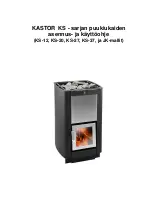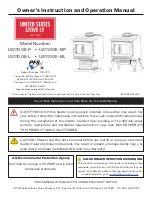
15
PROLONGED PERIODS OF NON USE
If the stove is to be left unused for a prolonged peri-
od of time then it should be given a thorough clean
to remove ash and unburned fuel residues. To
enable a good flow of air through the appliance to
reduce condensation and subsequent damage,
leave the air controls fully open.
It is important that the flue connection, any appliance
baffles or throat plates and the chimney are swept
prior to lighting up after a prolonged shutdown
period.
WARNING NOTE:
Properly installed, operated and maintained this
stove will not emit fumes into the dwelling.
Occasional fumes from the de-ashing and re-
fuelling may occur. However, persistent fume emis-
sion is potentially dangerous and must not be
tolerated. If fume emission does persist, then the
following immediate action should be taken:
(a) Open doors and windows to ventilate room.
(b) Let the fire out or eject and safely dispose of
fuel from the stove.
(c) Check for flue or chimney blockage and
clean if required.
(d) Do not attempt to relight the fire until the cause
of the fume emission has been identified and
corrected. If necessary seek expert advice.
The most common cause of fume emission is flue-
way or chimney blockage. For you own safety
these must be kept clean at all times.
GLASS CLEANING
The stove glass will self-clean when there is suffi-
cient heat generated by the burning fuel i.e. when
the unit is operated at the maximum air settings. If a
build-up of creosote occurs on the glass it may be
due to low draft conditions, poor quality fuel or oper-
ating the stove at the minimum air settings for long
periods of time. The glass should be cleaned when
cool and cleaned with a non-abrasive cloth using
warm soapy water. For stubborn deposits, a grade 0
steel wool can be used whilst tak¡ng care not to
scratch the glass with any coal/ash deposits.
CHANGING THE ROPE SEALS
The rope seal between the door & the front casting
will compress & harden over time and whilst small
adjustments can be made to the door catch to
ensure the integrity of the rope seal, it will be nec-
essary to replace the rope seals on the stove peri-
odically depending on stove usage. lt is recom-
mended that the rope seals are changed at least
every two years.
VITREOUS ENAMEL CLEANING
General cleaning must be carried out when the
stove is cool.
If this stove is finished in a high gloss vitreous
enamel, to keep the enamel in the best condition
observe the following tips:
1. Wipe over daily with a soapy damp cloth,
followed by a polish with a clean dry duster.
2. For stubborn deposits a soap impregnated
pad can be carefully used on the vitreous
enamel.
3. Use only products recommended by the
Vitreous Enamel Association, these products
carry the Vitramel label.
A detailed list of the approved cleaners can be found
on their website www.vea.org.uk/enamel-care/
DO NOT USE ABRASIVE PADS OR OVEN-
CLEANSERS CONTAINING CITRIC ACID ON
ENAMELLED SURFACES. ENSURE THAT THE
CLEANSER MANUFACTURERS INSTRUCTIONS
ARE ADHERED TO.
NOTE:
Small impact marks on the enamel finish can
be repaired using an appropriate enamel
touch up (a touch up bottle
i
s included with
the stove packaging) but it should not be
used to cover marks greater than ø10mm or
multiple marks on the same cast-
ing/area.
CLEANING A MATT BLACK/SENOTHERM
STOVE
Cleaning should be done when the stove is cold by
removing any dust or dirt using a dry cloth. Do not
use any water on the matt black/senotherm finish as
this will cause it to rust.
Содержание Oisin Eco
Страница 9: ...Fig 5 9 RECOMMENDED FLUE TERMINAL POSITION ...
Страница 17: ...OISIN SF NB ECO EXPLODED VIEW 17 ...
Страница 18: ...18 ...
Страница 19: ...19 NOTES ...






































